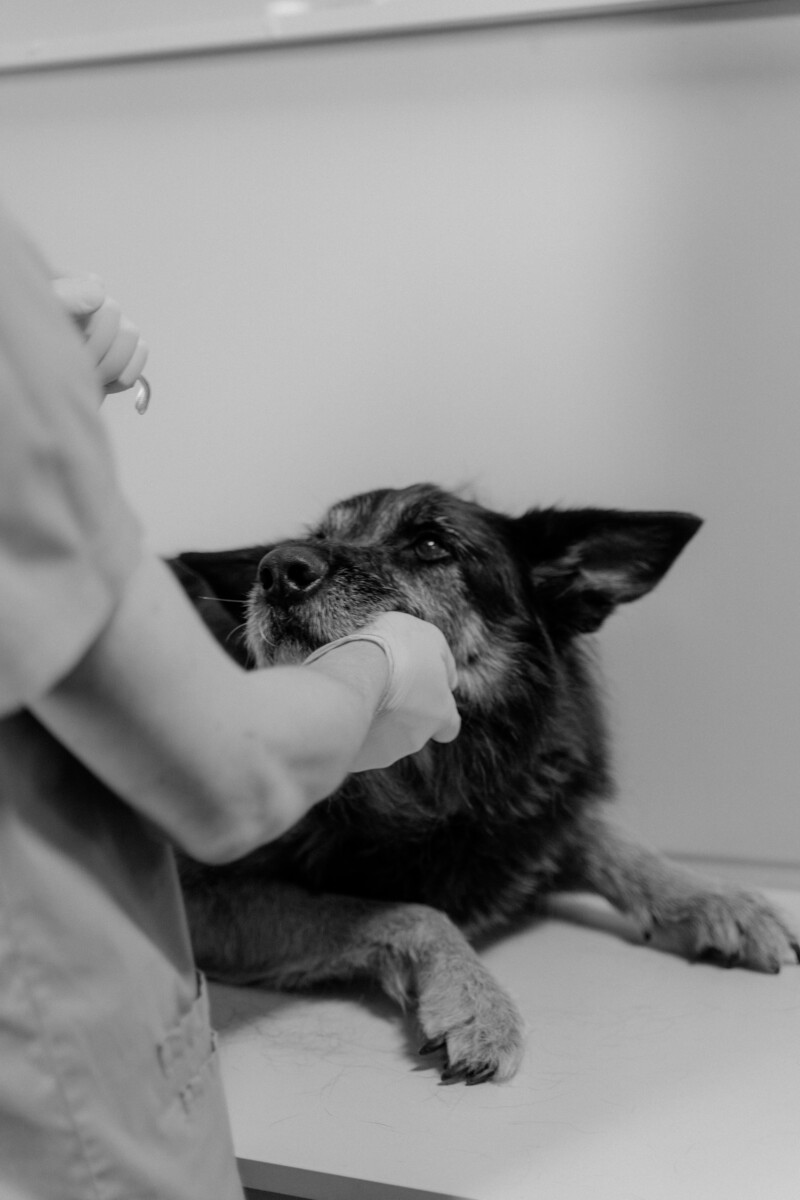
What To Use To Bandage A Dog?
Bandaging a dog can be a tricky task, but it is important to do it correctly to ensure the wound is properly protected and healing is not impeded. The type of bandage you use will depend on the size and location of the wound, as well as the type of injury. Generally, the best type of bandage to use for a dog is a non-adherent dressing, such as a gauze pad, followed by a self-adhesive bandage or an elastic bandage. It is important to use the right type of bandage to ensure the wound is properly protected and healing is not impeded.
What Types of Bandages Are Best for Dogs?
When it comes to bandaging your pup, there are a few different types of bandages that are best for dogs. The most common type of bandage is a self-adhesive bandage, which is a bandage that sticks to itself and is easy to apply. These are great for minor cuts and scrapes, and they come in a variety of sizes and colors.
Another type of bandage that is great for dogs is a gauze bandage. These are typically used for larger wounds and are more secure than self-adhesive bandages. They are also more absorbent, so they can help keep the wound clean and dry.
If your pup has a wound that needs to be kept clean and dry, an occlusive bandage is a great option. These are waterproof and airtight, so they can help keep the wound from getting infected. They are also great for keeping the wound from getting wet or dirty.
Finally, if your pup has a wound that needs to be kept in place, an elastic bandage is a great option. These are stretchy and can be used to wrap around the wound to keep it in place. They are also great for providing support and helping to reduce swelling.
No matter which type of bandage you choose, it’s important to make sure that it is the right size for your pup and that it is applied correctly. If you’re not sure how to apply a bandage, it’s best to consult your veterinarian for advice.
How to Properly Apply a Bandage to a Dog
Applying a bandage to a dog can be a tricky task, but it’s important to do it correctly to ensure your pup’s wound is properly protected. Here’s how to do it:
- Gather your supplies. You’ll need a bandage, scissors, and tape. If the wound is deep, you may also need a sterile gauze pad.
- Clean the wound. Use a damp cloth to gently clean the area around the wound. If the wound is deep, you may need to use a mild antiseptic.
- Cut the bandage. Cut the bandage to the size of the wound, making sure it’s long enough to wrap around the area at least once.
- Apply the bandage. Start by wrapping the bandage around the wound, making sure it’s not too tight. Secure the bandage with tape.
- Check the bandage. Make sure the bandage is secure and not too tight. If it’s too tight, it can cut off circulation and cause discomfort.
- Monitor the wound. Check the wound regularly to make sure it’s healing properly. If you notice any signs of infection, contact your vet right away.
Following these steps will help ensure your pup’s wound is properly protected and healing properly.
What to Do If a Dog’s Bandage Becomes Loose
If your dog’s bandage becomes loose, don’t panic! Here’s what you should do:
- Check the bandage for any signs of infection. If the area around the bandage is red, swollen, or oozing, contact your vet right away.
- If the bandage is just loose, you can try to re-wrap it. Make sure you use a clean bandage and wrap it snugly but not too tight.
- If you’re having trouble re-wrapping the bandage, or if the bandage is too tight, contact your vet for help.
- Keep an eye on the area and check it regularly for any signs of infection.
- If the bandage becomes loose again, contact your vet for advice.
Following these steps will help ensure that your dog’s bandage stays secure and that any potential infection is caught early.
How to Choose the Right Bandage for a Dog’s Injury
When your pup has an injury, it’s important to choose the right bandage to ensure proper healing. Here’s a guide to help you pick the best bandage for your pup’s injury.
First, assess the injury. Is it a minor scrape or a deep cut? Is it a wound that needs to be kept clean or one that needs to be kept dry? Knowing the type of injury will help you determine the best type of bandage.
Next, consider the size of the wound. If it’s a large wound, you’ll need a larger bandage. If it’s a small wound, you’ll need a smaller bandage.
Third, think about the location of the wound. If it’s on a joint or a hard-to-reach area, you’ll need a bandage that’s flexible and easy to apply.
Finally, consider the material of the bandage. If the wound is deep or prone to infection, you’ll want to use a bandage that’s made of a material that won’t irritate the skin.
Once you’ve assessed the injury, size, location, and material of the bandage, you’ll be able to choose the right bandage for your pup’s injury. With the right bandage, your pup will be on the road to recovery in no time!
What to Consider When Selecting a Bandage for a Dog
When selecting a bandage for your dog, there are a few things to consider.
First, you’ll want to make sure you choose the right size. Bandages come in a variety of sizes, so you’ll want to measure your dog’s wound and select a bandage that is slightly larger than the wound. This will ensure that the bandage is able to cover the wound completely and provide the necessary protection.
Next, you’ll want to consider the type of bandage you need. There are a variety of bandages available, including self-adhesive bandages, gauze bandages, and elastic bandages. Self-adhesive bandages are great for small wounds, while gauze and elastic bandages are better for larger wounds.
Finally, you’ll want to make sure the bandage is comfortable for your dog. Some bandages can be quite tight and uncomfortable, so you’ll want to make sure the bandage you choose is not too tight or too loose. You’ll also want to make sure the bandage is made of a material that won’t irritate your dog’s skin.
By taking the time to consider these factors, you can ensure that you select the right bandage for your dog’s wound.
How to Care for a Dog’s Bandage After Application
Once you’ve applied a bandage to your pup, it’s important to make sure it stays in place and is properly cared for. Here’s how to do it:
- Check the bandage regularly. Make sure it’s not too tight or too loose, and that it’s not slipping off. If it is, you may need to reapply it.
- Keep the area clean. Gently wash the area around the bandage with warm water and a mild soap. Don’t scrub too hard, as this could cause the bandage to come off.
- Keep the bandage dry. If the bandage gets wet, it can cause the wound to become infected. If your pup goes swimming or gets caught in the rain, make sure to dry the bandage off as soon as possible.
- Change the bandage regularly. Depending on the type of bandage, you may need to change it every few days. If the bandage is dirty or wet, you should change it immediately.
- Watch for signs of infection. If the area around the bandage is red, swollen, or oozing pus, it could be a sign of infection. If this happens, contact your vet right away.
By following these steps, you can make sure your pup’s bandage stays in place and is properly cared for.
What to Avoid When Bandaging a Dog
When bandaging a dog, there are a few things to avoid in order to ensure the safety and comfort of your pup.
First, avoid using too much tape or wrapping the bandage too tightly. This can cause discomfort and restrict the dog’s movement. It can also lead to skin irritation or even infection.
Second, avoid using materials that are too thick or bulky. This can make it difficult for the dog to move and can cause chafing or other skin irritation.
Third, avoid using materials that are too thin or flimsy. This can cause the bandage to come loose or unravel, which can be dangerous for the dog.
Fourth, avoid using materials that are not breathable. This can cause the dog to overheat and can lead to skin irritation or infection.
Finally, avoid using materials that are not washable. This can lead to bacteria and other germs building up on the bandage, which can be dangerous for the dog.
By avoiding these common mistakes, you can ensure that your pup is safe and comfortable while wearing a bandage.
Conclusion
The best type of bandage to use on a dog is a self-adhesive bandage. This type of bandage is easy to apply and can be used to cover wounds, protect against infection, and provide support for injured limbs. It is important to make sure the bandage is not too tight and that it is changed regularly to prevent infection. If the wound is deep or the dog is in pain, it is best to consult a veterinarian for proper treatment.

